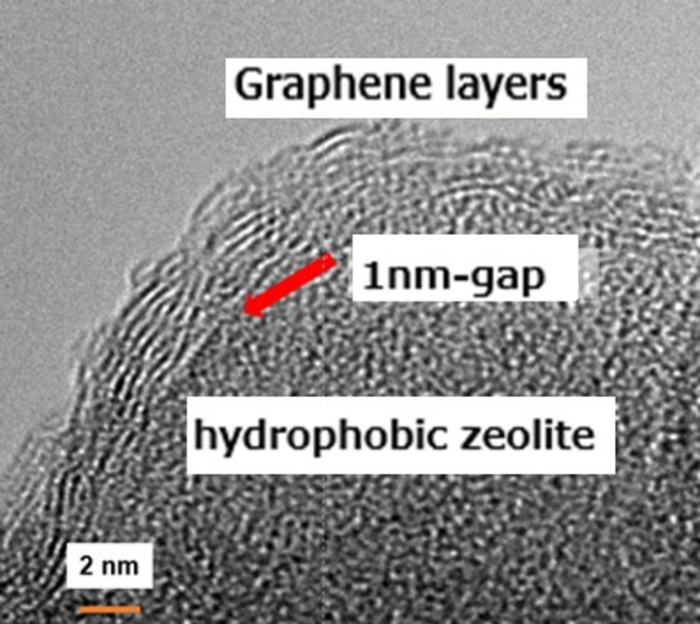The consequences of global warming are becoming much more severe, and technological advancements to reduce carbon dioxide emissions are in high demand. When hydrogen is burned, it produces water, making it an ideal source of clean energy.
 Transmission electron micrograph of graphene-wrapped zeolite. Image Credit: ©2022 The Authors, License 4.0 (CC BY-NC).
Transmission electron micrograph of graphene-wrapped zeolite. Image Credit: ©2022 The Authors, License 4.0 (CC BY-NC).
It is critical to develop safe, energy-efficient hydrogen production and storage technologies to enhance the use of hydrogen energy. As hydrogen is currently made from natural gas, it is not suitable for decarbonization. Separating hydrogen with a lot of energy would not qualify as clean energy. Polymer separation membranes are currently being researched all over the world.
Polymer separation membranes have the advantage of increasing the separation coefficient and widening the separation membrane. However, the rate of permeation through the membrane is extremely slow, necessitating the application of high pressure to speed up the process. As a result, using a polymer separation membrane requires a significant amount of energy.
The goal is to develop a new type of separation membrane technology that can accomplish separation speeds 50 times faster than existing separation membranes.
The graphene-wrapped molecular-sieving membrane developed has a separation factor of 245 and a permeation coefficient of 5.8 × 106 barrers, which is more than 100 times superior to traditional polymer separation membranes. If the separation membrane’s size is increased in the future, it is very likely that an energy-saving separation process for important gases like carbon dioxide and oxygen, as well as hydrogen, will be developed.
The hydrophobic graphene is covered around the MFI-type zeolite crystal. Due to the reduced repulsive interaction, the wrapping uses colloidal science principles to keep graphene and zeolite crystal planes close to each other. The zeolite crystals are encased in about five layers of graphene. Only hydrogen can pass through the narrow interface space.
The structure of the zeolite crystal cannot be seen because graphene is also present in the hydrophobic zeolite. As graphene has a strong attractive force, a simple compression treatment brings the zeolite crystals wrapped in graphene into close contact with each other, preventing any gas from passing through.
The surface of the zeolite crystal has grooves from the structure, and there is an interfacial channel between graphene and zeolite by which hydrogen molecules can selectively pass. The graphene model is used to connect the black circles, and there are nano-windows in some places. Any gas can freely pass through the nanowindows, but due to the extremely narrow channels between the graphene and zeolite crystal faces, hydrogen can permeate preferentially.
This structure allows for efficient hydrogen and methane separation. The movement of hydrogen, on the other hand, is accelerated due to the numerous voids between the graphene-wrapped zeolite particles. As a result, ultra-high-speed permeation can be achieved while maintaining a separation factor of 200 or higher.
The Robeson plot compares the hydrogen separation factor and gas permeation coefficient for methane with earlier reported separation membranes. This separation membrane separates hydrogen at a rate of about 100 times faster than conventional separation membranes while retaining a higher separation coefficient. The newly designed separation membrane, for the first time, has set the stage for energy-saving separation technologies.
Furthermore, this separation principle differs from traditional polymer dissolution and pore size separation in zeolite separation membranes, and it is dependent on the separation target by identifying the surface structure of zeolite or another crystal. In theory, high-speed separation for any target gas is possible.
As a result, if the separation membrane’s industrial manufacturing method and separation membrane become feasible, the chemical, combustion and other industries’ energy consumption can be significantly reduced, resulting in a considerable reduction in carbon dioxide emissions.
The researchers are currently working on developing basic technology for quickly generating large amounts of enriched oxygen from the air. Technology for producing enriched oxygen will revolutionize the steel and chemical industries, as well as medicine.
The CREST project “Creation of Innovative Functional Materials with Advanced Properties by Hyper-Nanospace Design,” the JST-OPERA project (JPMJOP1722), the NEDO Feasibility Study Program, and TAKAGI Co., Ltd. all supported the research.
Journal Reference:
Kukobat, R., et al. (2022) Ultrapermeable 2D-channeled graphene-wrapped zeolite molecular sieving membranes for hydrogen separation. Science Advances. doi.org/10.1126/sciadv.abl3521.